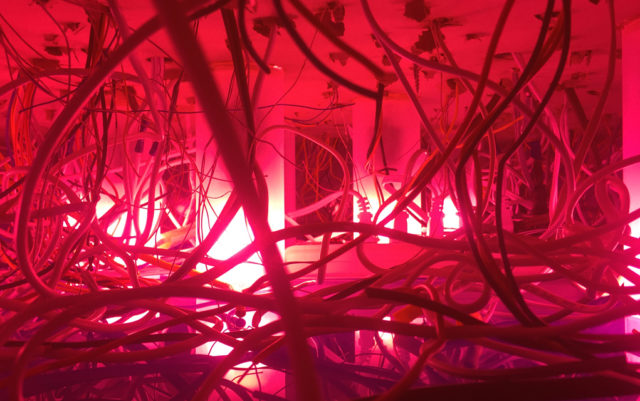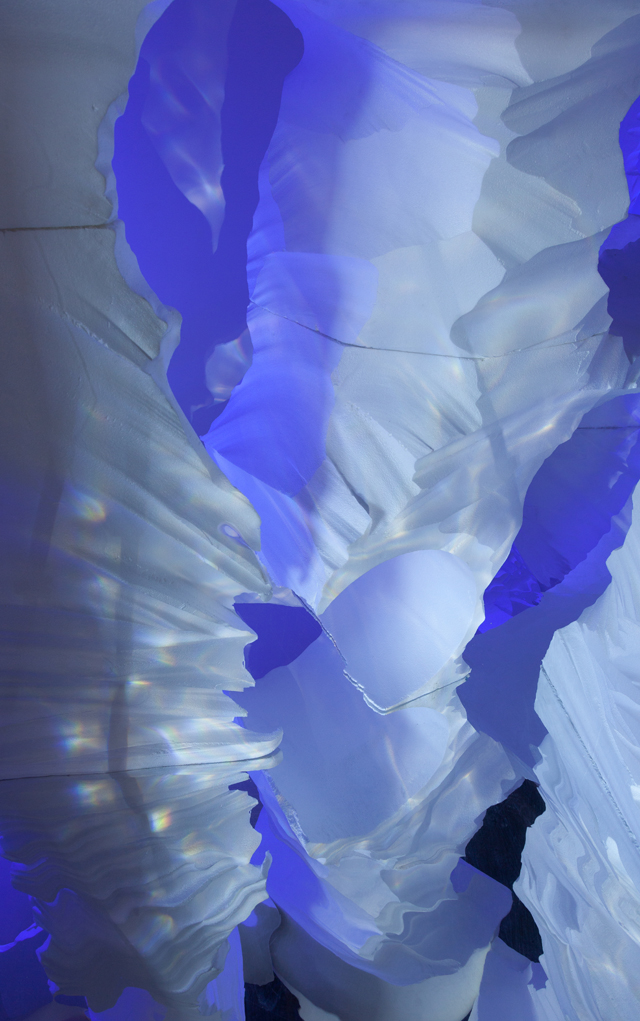
There is an element of concealment in the installation art show Material Nature by Katie Caron, on exhibition at Longmont’s Firehouse Art Center, a sense that all is not what it seems. The viewer recognizes the forms on display as natural environments, but there is also something unnerving that raises an instinctive defensiveness, a lurking resistance to recognize the art as beautiful.
“My work tends to have this dark undercurrent, this idea of the uncanny,” Caron says. “The term uncanny comes from the German word unheimlich, which has to do with the unhomely. The things that we find uncanny are actually the things that are most familiar to us, but not of the home and that is what we find to be creepy. The exhibition deals with the fact that we are living in global warming and that’s all apocalyptic.”
An apocalypse suggests an event, a complete and final ending of life as we know it and usually arrives by some outside force. But global warming resists that characterization, slowly unfolding as a by-product of our own consumer culture.
Through her work, Caron pays close to attention to how we react psychologically to the strange predicament of being responsible for own undoing. She notices that we are in denial — both too close to our actions to change them and too far removed from their consequences to comprehend their effect. She questions if we are able to escape the culture of consumerism or if it is too late, if consumerism has become synonymous with living.
Caron’s installations offer an opportunity to gain distance and perspective on the doomsday threat of ecosystem collapse by creating dramatic spaces and environments that she equates to the theatrical.
“I always put a sort of filter or membrane between the viewer and the object to give it a level of concealment that psychologically draws the viewer in to be more curious and to come in a little bit closer than they would if it was real,” Caron says. “By creating separation, the viewer can escape the bounds of reality to explore and interact with what they take to be an illusion.”

“Glacial Retreat” is the dramatic lifeblood of the show. In the back corner of the gallery, white pillars of Styrofoam rest on top of a reflective floor, illuminated with soft blue lighting. The effect is a larger than life replication of the glow from glacial ice that happens as light bounces and refracts around its molecular structure.
The Styrofoam is a perfect mimicry of ice, marked with striations from a knife used to carve the surface, just as ice is etched by rocks that scratch its surface while it moves and melts. But the top of the shapes are left uncarved and retain the form of their manufacturing, leaving a powerful reminder that while the foam looks like ice, it is not, nor is it supposed to be, ice.
In the context of global warming, Caron’s work takes on a powerful symbolism, replacing the ice that is melting as sea temperatures rise. In the United States, containers and packaging constitute the largest portion of the generated municipal solid waste, making up about 30 percent. By using these materials in her work, Caron reflects this reality back to the viewer, an opportunity to consider the repercussions of consumerism.
“We are packaging our world, which is nature, with synthetic materials creating constructed environments,” Caron says. “I am trying to deal with this version of nature, with the whole green culture which is actually quite false and just used for advertising. It’s just more packaging, more marketing. The question is how much are we really willing to change our personal habits if we are born into this culture of consumption that is rampant and out of control?”

“Dominium,” a mechanical installation standing in the center of the gallery, challenges the idea that free will remains intact in a consumer culture. The piece is a large, layered plastic cube that stands waist high so that your hands want to reach out and touch the plastic surface that looks like a micro civilization. Small, loose pieces of iron dance on top of the plastic moved by motorized magnets that creak and groan underneath.
Below the surface are layers, like those of the earth, but these are parts of a machine — the battery to power, the wires to conduct electricity, the motors to move magnets — all of which serve to animate life on the surface. The iron moves across its plastic landscape, unaware that its movement is not its own, but conducted by a bigger mechanized system.
The resemblance of Caron’s installations to life is uncanny — lifelike but not life at all. It is a mimicry, or worse, a replacement. In the context of global warming, Caron reflects the consequences of our actions back to us by substituting a cheap and packaged beauty for true, natural beauty, exposing what is lost in that substitution.














